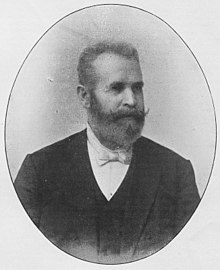Sigmund Riefler
Sigmund Riefler (born August 9, 1847 in Maria Rain ; † October 21, 1912 in Munich ) was a German physicist , inventor and precision watchmaker .
Life
Sigmund Riefler was on August 9, 1847 Maria Rain, the son of drawing instruments - and clocks -Fabrikanten Clemens Riefler born. He attended the trade school in Kaufbeuren and practically trained as a mechanic in his father's company . In the years 1865-70 he studied mathematics , geodesy and mechanical engineering at the Technical University in Munich and physics and astronomy at the University of Munich . He then worked as an engineer at the Royal Prussian Land Survey in Schleswig .
In 1876, after the death of his father, he took over the management of the Clemens Riefler company with two brothers (Adolf and Theodor) . Sigmund mainly worked on new developments in the field of compasses and precision pendulum clocks , while his brothers shared the technical and commercial management of the company in Maria Rain.
In 1878 he settled in Munich in order to be in contact with the scientific institutes there. After various other new designs in the field of drawing instruments, he turned to precision watchmaking towards the end of the 1880s, which u. a. to the development of the Riefler pendulum , the spring force and gravity escapement. The precision pendulum clock from Riefler has a rate accuracy of ± 4 × 10 −4 s / day or about a seventh of a second a year and is thus still the most precise mechanical watch. A total of 635 of these clocks were made, which were in use worldwide, including in over 150 observatories. However, their production was stopped in 1965 with the introduction of atomic clocks .
He died in Munich on October 21, 1912 at the age of 65. His grave is in the old northern cemetery in Munich.

Left: "Type A" with air pressure compensation
Right: "Type D" in a glass cylinder

Awards
- 1894 John Scott Medal from the Franklin Institute in Philadelphia / USA
- 1897 Honorary doctorate (Dr. phil. Hc) from the Philosophical Faculty of the University of Munich.
- 1899 Sigmund and both brothers receive honorary citizenship of the Nesselwang market (new location of the company since 1879)
- 1900 Golden Delbrück memorial coin of the association for the promotion of industry in Prussia .
- 1905 Commerzienrat title
Patents
- 1889 DRP No. 50739 Double wheel escapement for chronometers with completely free balance and for pendulum clocks with free pendulum .
- 1891 DRP No. 60059 mercury compensation pendulum .
- 1897 DRP No. 100870 pendulum with nickel steel rod and several interacting compensation tubes .
- 1903 DRP No. 151710 Electric winding device for watches with a driving weight lever and an electromagnet for lifting the same .
- 1913 DRP No. 272119 Gravity escapement with two drive levers .
literature
- Hans-Heinrich Schmid : Lexicon of the German watch industry 1850–1980: company addresses, production program, company logos, brand names, company histories . (3rd expanded edition 2017) Publisher: German Society for Chronometry 2017; ISBN 978-3-941539-92-1
- Carl Preyß: Riefler, Sigmund. In: New German Biography (NDB). Volume 21, Duncker & Humblot, Berlin 2003, ISBN 3-428-11202-4 , p. 577 f. ( Digitized version ).
- Riefler, Dieter: Riefler precision watches: 1890-1965 ; Callwey Verlag; Munich 1991; ISBN 3-7667-1003-6
- Hans-Heinrich Schmid: Dr. phil. hc Sigmund Riefler- On the hundredth anniversary of death. in the 2012 annual, volume 51, p. 83f; DGC (Ed.), Stuttgart 2012
- Eduard C. Saluz: The engineer as a watchmaker. in annual journal 2012, volume 51, p. 89f; DGC (Ed.), Stuttgart 2012
Web links
- Works by and about Sigmund Riefler in the German Digital Library
- Search for Sigmund Riefler in the SPK digital portal of the Prussian Cultural Heritage Foundation
- Clock cabinet of the Staatliche Museen Kassel: precision pendulum clock in a pressure-tight tank
- Ladd Observatory: Riefler Precision Clock
Individual evidence
- ^ Curt Dietzschold: Dr. Sigmund Riefler . In: The Cornelius Nepos the watchmaker . Contains 35 biographies and portraits of watchmakers, scholars who pave the way for watchmaking and personalities who promote the watchmaking trade. A contribution to business promotion. 1st edition. Dietzschold's Verlag, Krems ad Donau 1910, p. 57 .
- ^ Erbrich, Klaus: Precision pendulum clocks: from Graham to Riefler ; Callwey Verlag; Munich 1978; ISBN 3-7667-0-429-X
| personal data | |
|---|---|
| SURNAME | Riefler, Sigmund |
| ALTERNATIVE NAMES | Riefler, Siegmund |
| BRIEF DESCRIPTION | German physicist, watchmaker and manufacturer |
| DATE OF BIRTH | August 9, 1847 |
| PLACE OF BIRTH | Maria Rain (Bavaria) |
| DATE OF DEATH | October 21, 1912 |
| Place of death | Munich |

